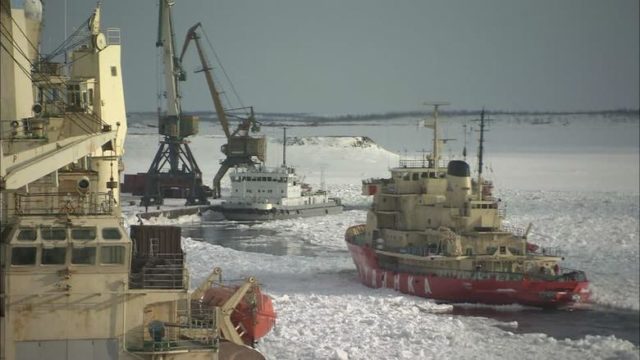
Russia Lacks Sufficient Infrastructure and Cadres to Control Northern Sea Route
Publication: Eurasia Daily Monitor Volume: 15 Issue: 172
By:

In recent months, Russian and Western media outlets have trumpeted what they describe as Russia’s enormous success in developing the Northern Sea Route (NSR), which will shorten the time needed for shipping between East Asia and Europe—particularly now that global warming is lengthening the season during which ships can use this Arctic passage (RT, December 5). And because Moscow insists that its ships must dominate the situation (see EDM, December 4), many are assuming that this development has already given Moscow another geopolitical victory over the West.
But such upbeat predictions ignore two realities. First, Russia does not have the necessary infrastructure to make the Northern Sea Route work as a Russian waterway and will not for at least another decade. And second, it lacks sufficient numbers of seamen and officers to man the ships it has announced it will be building over the next 20 years. And those in fact may not be built because of rising prices and budget cuts (Dp.ru, Portnews.ru, December 5). As a result, Russia will either take a back seat to China in the development of the NSR as it grows, something certain to change the geopolitical balance in the Arctic, or Moscow will have to strip resources from other projects to develop both ships and coastal facilities in support of its hopes to be the dominant player. At present, all hype notwithstanding, the first outcome seems far more likely than the second.
Moscow journalist Andrey Belenky says that, in the opinion of the Russian expert community, their country lacks the infrastructure needed to make the Northern Sea Route popular with shippers. And at the current rate of development, the transit corridor will remain logistically deficient for at least another decade or more (Dailystorm.ru, September 11). On the northern coast of Russia, along the NSR, for example, there are only seven ports, “and at only one of them—at Dudinka, where the Yenesei [River] flows into the Kars Sea—does the amount of trade exceed a million tons a year.” The rest of the area is vacant, and building needed infrastructure there is incredibly expensive.
A single new electric and natural gas line across the region would cost more than half of what the dual-string 31.5 billion cubic meter TurkStream pipeline has cost to build, Belenky says. But without such necessary infrastructure improvements, trade among Russian regions in the High North will remain small. Moreover, international shipping will increasingly pass beyond Russia’s control, especially as ice breakers become less necessary to make the transit. Moscow has been putting money into the Murmansk port, even though, technically, it is not on the NSR. But that investment “is the exception,” Russian experts told the journalist. Most projects in the region are either “far from completion” or still at the stage of talks rather than construction, according to Igor Orlov, an aide to the governor of Arkhangelsk Oblast.
The planned expansion of the Arkhangelsk port “also will not be completed soon.” Its first stage will not be realized until 2023; and its second—not until 2028. Thus, those who want to rely on it will have to wait “another ten years in the best case,” Belenky says. And the best case is unlikely. Tensions with the West have slowed or stopped many of these projects, he continues, because, as Murmansk Governor Marina Kovtun puts it, “no projects in the Arctic are possible without international cooperation.” And at present, that does not exist, at least in the amount necessary to proceed.
With regard to infrastructure, Moscow has talked more than it has done, the journalist says. During the presidency of Dmitry Medvedev, there was talk about creating a Ministry for the Arctic; but that never materialized. A little later, then–deputy prime minister Dmitry Rogozin said there would be some special state corporation to focus on this area. But that has not happened either. “The growth of the Russian economy is slowing,” Belenky writes, “and the Northern Sea Route could change this. But judging from the timetables of projects around it, the country needs a minimum of ten more years for preparation.” The ice on the Arctic Ocean will continue to melt. Consequently, “each additional year, without new infrastructure, will be a missed opportunity for profit for Russia.”
However, there is an even more immediate and more difficult problem Moscow must address if it is to dominate trade on this route: there simply are not enough experienced Russian sailors and officers to man the ships Moscow wants to make use of. Under Russian law, the officers of ships sailing under the Russian flag must be Russian citizens, have experience in sailing in Arctic waters, and also be knowledgeable about ships carrying liquefied natural gas (LNG), an increasingly important cargo on the route. At present, the “Neratka” Telegram Channel says, “there are almost no such people, and they are not going to appear in the necessary numbers anytime soon” (T.me/neratka, November 23).
That means, according to Russia’s Rex news agency, that “the only way out is through the foreign registration of ships.” Though such a solution would contradict Moscow’s policy that explicitly requires such vessels to obtain special permission from Russia in every case. Indeed, Rex continues, Russian officials currently “dream of completely banning the use of vessels with foreign registration on the Northern Sea Route.” But for at least two decades, Moscow will have to choose: maintaining such control and seeing the amount of carried cargo be less than would otherwise be the case, or acknowledging that Moscow has no ability to impose such control and allow China and other countries to emerge as the dominant players along a route Vladimir Putin has described as a key to Russian security (Iarex.ru, November 27).



